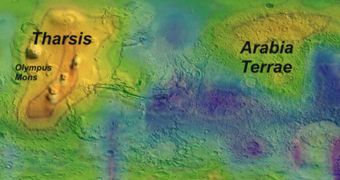A team of expert has recently published the results of a new study, which shed more light onto why methane concentrations in the Martian atmosphere get depleted at an abnormally-high speed.
One of the first things researchers noticed when the first chemical analysis instruments were trained on the Martian atmosphere was that the planet appeared to be losing methane at a very high rate.
All the amounts of the stuff that were initially detected faded away from sight in less than a Martian year, which has about 22 Earth months.
The new investigation managed to produce an in-depth map of the methane concentrations on Mars, as well as of the places where most of the gas disappears.
The work reveals that variations in the way methane is broken apart exist, and also that they depend on season, location and year. This has never been shown to be the case before.
The methane cycle therefore peaks in regions where the largest amounts of underground water can be found. High activity levels are also recorded in areas that previously exhibited volcanic activity.
But, rather than settling some long-standing debates about Mars, the new investigation actually deepens the mystery as to the source of the Martian methane.
A part of the international scientific community believes that the carbon compound may be produced by microorganisms still living on Mars, or that are now decomposing, whereas other experts believe non-biological explanations exist for the gas.
“The source of the methane could be geological activity or it could be biological – we can't tell at this point. However, it appears that the upper limit for methane lifetime is less than a year in the Martian atmosphere,” says Universita del Salento expert Sergio Fonti.
On Earth, methane can indeed be produced by animals, such as cows and goat, but it can also be generated as organic matter decomposes inside swamps.
On the gas giants of our solar system, Jupiter, Saturn, Neptune and Uranus, methane exists naturally in the atmosphere. But the Martian atmosphere is made up of 95 percent carbon dioxide, and only small traces of methane.
“It's evident that the highest concentrations are associated with the warmest seasons and locations where there are favorable geological – and hence biological – conditions such as geothermal activity and strong hydration,” Fonti reveals, quoted by Space.
“The higher energy available in summer could trigger the release of gases from geological processes or outbreaks of biological activity,” he concludes.

 14 DAY TRIAL //
14 DAY TRIAL //